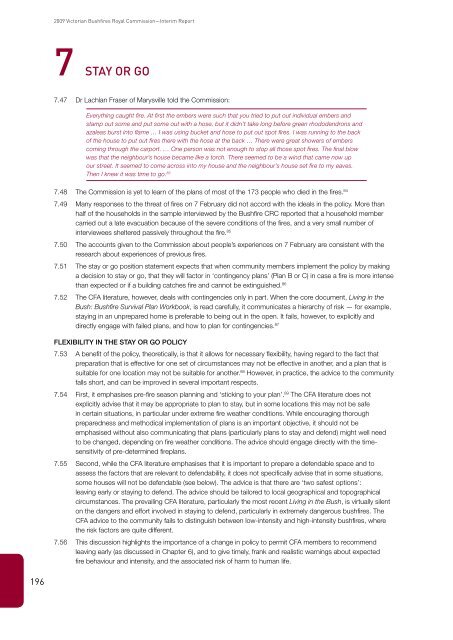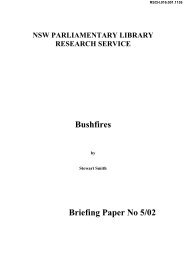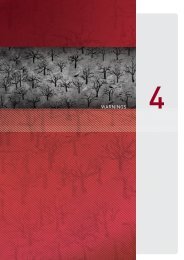Chapter 7 - Stay or go - 2009 Victorian Bushfires Royal Commission
Chapter 7 - Stay or go - 2009 Victorian Bushfires Royal Commission
Chapter 7 - Stay or go - 2009 Victorian Bushfires Royal Commission
Create successful ePaper yourself
Turn your PDF publications into a flip-book with our unique Google optimized e-Paper software.
<strong>2009</strong> Vict<strong>or</strong>ian <strong>Bushfires</strong> <strong>Royal</strong> <strong>Commission</strong>—Interim Rep<strong>or</strong>t<br />
7 <strong>Stay</strong> <strong>or</strong> Go<br />
7.47<br />
Dr Lachlan Fraser of Marysville told the <strong>Commission</strong>:<br />
Everything caught fire. At first the embers were such that you tried to put out individual embers and<br />
stamp out some and put some out with a hose, but it didn’t take long bef<strong>or</strong>e green rhododendrons and<br />
azaleas burst into flame … I was using bucket and hose to put out spot fires. I was running to the back<br />
of the house to put out fires there with the hose at the back … There were great showers of embers<br />
coming through the carp<strong>or</strong>t. … One person was not enough to stop all those spot fires. The final blow<br />
was that the neighbour’s house became like a t<strong>or</strong>ch. There seemed to be a wind that came now up<br />
our street. It seemed to come across into my house and the neighbour’s house set fire to my eaves.<br />
Then I knew it was time to <strong>go</strong>. 83<br />
84<br />
7.48 The <strong>Commission</strong> is yet to learn of the plans of most of the 173 people who died in the fires.<br />
7.49<br />
7.50<br />
7.51<br />
Many responses to the threat of fires on 7 February did not acc<strong>or</strong>d with the ideals in the policy. M<strong>or</strong>e than<br />
half of the households in the sample interviewed by the Bushfire CRC rep<strong>or</strong>ted that a household member<br />
carried out a late evacuation because of the severe conditions of the fires, and a very small number of<br />
interviewees sheltered passively throughout the fire. 85<br />
The accounts given to the <strong>Commission</strong> about people’s experiences on 7 February are consistent with the<br />
research about experiences of previous fires.<br />
The stay <strong>or</strong> <strong>go</strong> position statement expects that when community members implement the policy by making<br />
a decision to stay <strong>or</strong> <strong>go</strong>, that they will fact<strong>or</strong> in ‘contingency plans’ (Plan B <strong>or</strong> C) in case a fire is m<strong>or</strong>e intense<br />
than expected <strong>or</strong> if a building catches fire and cannot be extinguished. 86<br />
7.52 The CFA literature, however, deals with contingencies only in part. When the c<strong>or</strong>e document, Living in the<br />
Bush: Bushfire Survival Plan W<strong>or</strong>kbook, is read carefully, it communicates a hierarchy of risk — f<strong>or</strong> example,<br />
staying in an unprepared home is preferable to being out in the open. It fails, however, to explicitly and<br />
directly engage with failed plans, and how to plan f<strong>or</strong> contingencies. 87<br />
FLEXIBILITY IN THE STAY OR GO POLICY<br />
7.53 A benefit of the policy, the<strong>or</strong>etically, is that it allows f<strong>or</strong> necessary flexibility, having regard to the fact that<br />
preparation that is effective f<strong>or</strong> one set of circumstances may not be effective in another, and a plan that is<br />
suitable f<strong>or</strong> one location may not be suitable f<strong>or</strong> another. 88 However, in practice, the advice to the community<br />
falls sh<strong>or</strong>t, and can be improved in several imp<strong>or</strong>tant respects.<br />
89<br />
7.54 First, it emphasises pre-fire season planning and ‘sticking to your plan’. The CFA literature does not<br />
explicitly advise that it may be appropriate to plan to stay, but in some locations this may not be safe<br />
in certain situations, in particular under extreme fire weather conditions. While encouraging th<strong>or</strong>ough<br />
preparedness and methodical implementation of plans is an imp<strong>or</strong>tant objective, it should not be<br />
emphasised without also communicating that plans (particularly plans to stay and defend) might well need<br />
to be changed, depending on fire weather conditions. The advice should engage directly with the timesensitivity<br />
of pre-determined fireplans.<br />
7.55<br />
7.56<br />
Second, while the CFA literature emphasises that it is imp<strong>or</strong>tant to prepare a defendable space and to<br />
assess the fact<strong>or</strong>s that are relevant to defendability, it does not specifically advise that in some situations,<br />
some houses will not be defendable (see below). The advice is that there are ‘two safest options’:<br />
leaving early <strong>or</strong> staying to defend. The advice should be tail<strong>or</strong>ed to local geographical and topographical<br />
circumstances. The prevailing CFA literature, particularly the most recent Living in the Bush, is virtually silent<br />
on the dangers and eff<strong>or</strong>t involved in staying to defend, particularly in extremely dangerous bushfires. The<br />
CFA advice to the community fails to distinguish between low-intensity and high-intensity bushfires, where<br />
the risk fact<strong>or</strong>s are quite different.<br />
This discussion highlights the imp<strong>or</strong>tance of a change in policy to permit CFA members to recommend<br />
leaving early (as discussed in <strong>Chapter</strong> 6), and to give timely, frank and realistic warnings about expected<br />
fire behaviour and intensity, and the associated risk of harm to human life.<br />
196
















